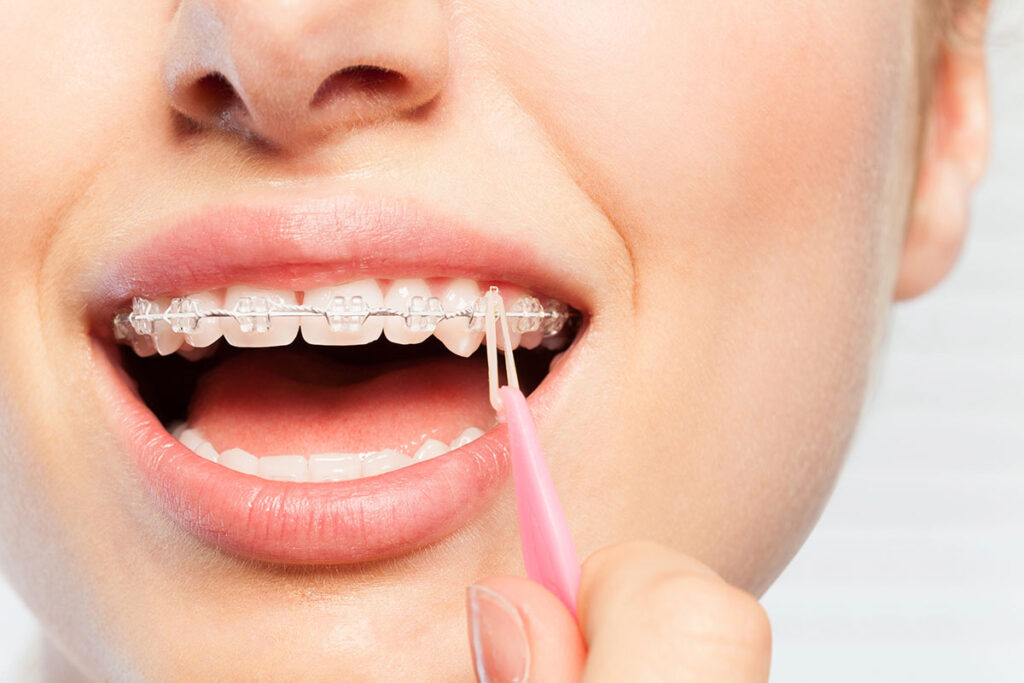Rubber Bands for Braces 101

If you’re getting used to having braces, you might notice that, along with brackets and wires, your orthodontist has added tiny rubber bands. If you’re a teen who’s over having braces by this point, this might be pretty annoying — but it’s essential to your treatment.
These rubber bands create extra tension, which helps to gradually move your teeth and align your jaw in the right direction. We’ll be talking about what, exactly, rubber bands do below, so stick around! We’ll also be providing some tips for teens and parents to make rubber bands more manageable.
What Are Rubber Bands for Braces?
Rubber bands (also called “elastics”), are small, colorful bands that you’ll sometimes see on braces. There are two main types of rubber bands for braces:
Ligatures
These rubber bands wrap around each bracket to keep the archwire (the main wire of your braces) in place. They will be switched out by your orthodontist during each appointment.
Interarch Rubber Bands
These are the rubber bands that help adjust your bite and jaw alignment. Not everyone needs these, but your orthodontist may recommend them if it’s necessary to correct the way your upper and lower teeth fit together.
These are special rubber bands made specifically for orthodontic treatment. You definitely shouldn’t try to substitute with regular rubber bands. Rubber bands for orthodontic treatment are made with a specific tension to ensure safe movement.
How Do Rubber Bands for Braces Work?
Usually, you’ll have a rubber band on each side of your mouth. They’re attached to a bracket on your upper teeth (often near your canine), and then stretched down to a bracket on your lower molars. The bands pull on your teeth and jaws, working with the wires and brackets to gently shift your teeth into place.
This additional tension can be uncomfortable at first, but as your mouth gets used to it, it will become much less noticeable. Rubber bands also help make sure that the archwire stays stable. This will provide the steady force that drives your treatment.
Tips for Wearing Rubber Bands on Braces
Wearing your rubber bands consistently is more important than you might think. Skipping days or taking breaks can slow down your progress, which means you’ll have to spend more time in braces. Here are some tips for wearing rubber bands:
Use Both Hands to Attach
In the beginning, it might be a bit tricky to get the rubber bands on. Use both your thumb and pointer finger to hook them on. We’d recommend doing this in front of a mirror. It takes practice, but with time, it’ll get easier.
Keep Them in a Safe Place
The rubber bands come in small bags that are easy to lose. Try keeping them somewhere safe so you always have extras on hand. This is especially important for parents to keep in mind if their child or teen has pediatric braces.
Replace Daily
Rubber bands wear out from all that tension, so you’ll want to change them every day in order to maintain consistent pressure. Replace both sides at the same time, even if only one rubber band breaks.
Take Them Out for Eating and Brushing
You’ll also want to remove your rubber bands whenever you eat or brush your teeth. Just remember to put them back in as soon as you’re done.
Staying Motivated to Wear Rubber Bands Every Day
If you’re looking to get teen braces in Philadelphia (along with rubber bands), you’re in the right place. At Philly Braces (Cohen & Kotecki), we understand how frustrating it can be to wear rubber bands on your braces as a teen, and we want to make the experience as painless as possible for you.
While wearing rubber bands can be a bit annoying (especially at first), it’s completely necessary. You need to wear your rubber bands if you want to achieve the results you want. If you don’t wear them regularly, your treatment might take longer, which obviously isn’t ideal. Here are some strategies that teens and parents can use to stay on track:
For Teens
If you’re trying to keep yourself motivated to wear your rubber bands, think about setting reminders for yourself. For example, you might stick a note on your bathroom mirror or set an alarm on your phone.
You can also search online or ask your orthodontist to find out what happens when treatment is delayed. For example, decalcification (white spots on teeth) can happen if braces are worn for longer than planned.
For Parents
Parents can encourage their kids or teens with positive reinforcement. If your child wears their rubber bands daily, consider rewarding them with a treat at the end of the week (like ice cream or dinner at their favorite restaurant). You might even mark off each successful day on a calendar to build consistency.
If rewards aren’t enough, negative reinforcement may also be helpful. For example, if your child isn’t wearing their rubber bands, you could take away certain privileges (like screen time). Kids are more likely to comply when they see that wearing their rubber bands is non-negotiable.
Frequently Asked Questions
Are Rubber Bands Uncomfortable?
Rubber bands can feel tight or even sore at first, but this usually goes away as your mouth adjusts to them. The soreness is actually a sign that your teeth are moving in the right direction. Just stick with it — you’ll get used to them in time!
Will I Need Rubber Bands the Whole Time I Have Braces?
Sometimes, but this isn’t always the case. Rubber bands are typically only needed for part of your treatment. Once your teeth and jaw are aligned correctly, your orthodontist may let you stop wearing them.
Conclusion
Rubber bands might seem like a hassle at first, but they’re incredibly important. They help adjust your bite, align your jaw, and make sure that your teeth move into the right positions. If you wear your rubber bands as instructed, you’ll be well on your way to achieving the smile you’ve always wanted.








